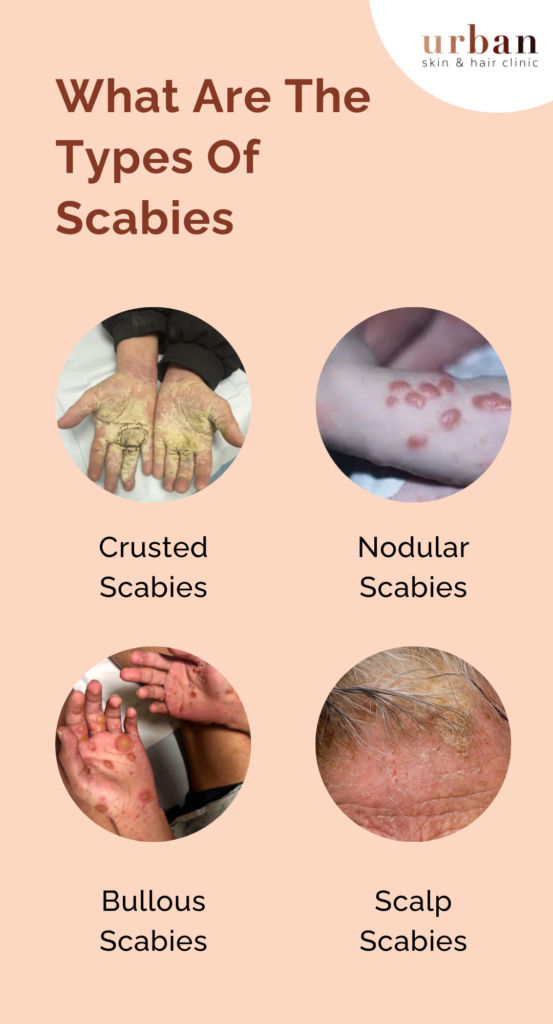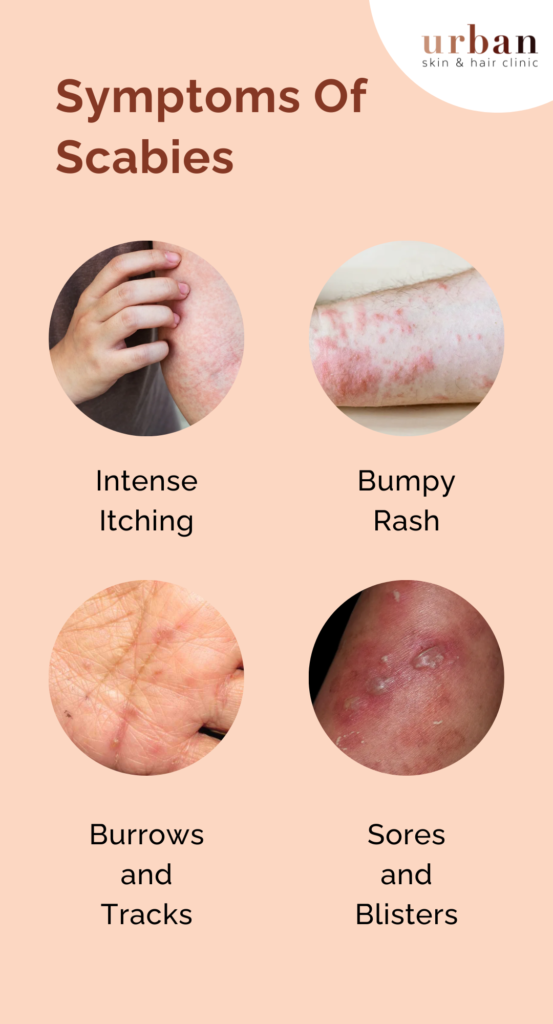What is scabies?
Scabies is a contagious skin infestation caused by tiny mites known as Sarcoptes Scabiei. These microscopic mites burrow into the skin, where they lay eggs and reproduce, leading to an infestation. The condition is characterized by intense itching, especially at night, and the appearance of a red, raised, or bumpy rash with small tracks or burrows on the skin.
Scabies is commonly spread through prolonged, close skin-to-skin contact with an infested person, but it can also be transmitted by sharing personal items like clothing or bedding. It is crucial to seek professional medical help for accurate diagnosis and effective treatment of scabies.
What are the Types of scabies?
Scabies is a skin infestation caused by the Sarcoptes scabiei mite and can manifest in various forms. Identifying the specific type of scabies is essential for effective treatment. Below are the different types of scabies:
- Crusted (Norwegian) Scabies: Crusted scabies predominantly affects individuals with weakened or faulty immune systems. It is characterized by the formation of thick, crusted areas covering a large portion of the skin. Unlike typical scabies, crusted scabies infestations can involve an overwhelming number of mites, sometimes reaching millions, as opposed to the usual 10 to 15 mites seen in classic scabies cases. Due to its severity and increased mite load, crusted scabies can be highly contagious and challenging to manage. Professional medical attention and specialized treatment are often necessary to address this type of scabies effectively.
- Nodular Scabies: Nodular scabies is more commonly observed among children. In this type, brown-red nodules may persist on the skin even after the mite infestation has been treated. These nodules are a result of the body’s inflammatory response to the presence of the mites and can take time to resolve fully.
- Bullous Scabies: Bullous scabies can be mistaken for a condition called bullous pemphigoid, which involves skin blisters. It is more commonly seen in adults. In this type of scabies, the infestation leads to the development of large fluid-filled blisters on the skin, causing discomfort and confusion with other blistering skin disorders. Accurate diagnosis by a medical professional is essential to differentiate bullous scabies from similar skin conditions.
- Scalp Scabies: As the name suggests, scalp scabies occurs on the scalp and is characterized by the presence of scales that may resemble psoriasis. Unlike typical scabies, scalp infestations may not present the hallmark signs of itching and burrows. Diagnosis can be challenging without a thorough examination by a dermatologist or a qualified healthcare provider.

What are the Causes of scabies?
Scabies is caused by a parasitic infestation of the skin due to a tiny mite known as Sarcoptes scabiei. The mite is responsible for the transmission of the condition, and understanding its modes of transmission is essential to prevent and manage scabies effectively. Here are the primary causes of scabies:
- Direct Skin-to-Skin Contact: The most common mode of transmission for scabies is direct, prolonged skin-to-skin contact with an infested individual. The mites can easily crawl from one person’s skin to another during close physical contact, such as hugging, holding hands, or intimate interactions. Scabies is often transmitted between family members, sexual partners, and individuals living in crowded or close living conditions.
- Sharing Personal Items: Scabies mites can also be transmitted indirectly through the sharing of personal items that have been in contact with an infested person. Items such as clothing, bedding, towels, and even furniture can harbor mites and their eggs. When an uninfested person comes into contact with these items, the mites can transfer to their skin, leading to a new infestation.
- Transmission in Healthcare Settings: In healthcare facilities, scabies can spread from patient to patient, particularly in hospitals, nursing homes, or long-term care centers. This type of transmission is less common but can occur due to prolonged exposure to infested individuals in medical settings.
Signs & Symptoms of scabies
Scabies infestation can cause a range of bothersome symptoms, and recognizing these signs is crucial for early diagnosis and treatment. If you suspect scabies or experience any of the following symptoms, it’s essential to seek professional medical evaluation at Urban Skin & Hair Clinic for accurate diagnosis and appropriate management. The common signs and symptoms of scabies include:
- Intense Itching: One of the hallmark features of scabies is relentless itching, particularly at night. The itching is a result of the mites burrowing into the skin and laying eggs, triggering an allergic reaction. The itchiness may become more severe over time, leading to considerable discomfort and sleep disturbances.
- Red, Raised, or Bumpy Rash: Scabies often causes the appearance of a rash on the skin. The rash may consist of red, raised, or bumpy patches, which can vary in size and distribution. The affected areas may include the wrists, elbows, armpits, genital area, buttocks, and spaces between the fingers.
- Burrows and Tracks: In typical scabies, the mites create small, thread-like burrows or tracks in the skin. These burrows are thin, grayish, or skin-colored lines that are visible upon close inspection. They usually occur in the folds of the skin or areas with thinner skin, such as the webs of fingers or toes.
- Sores and Blisters: Due to the persistent scratching in response to the itching, scabies-infested skin may develop sores and blisters. Scratching can lead to open wounds, making the skin vulnerable to secondary bacterial infections.
If you or someone you know is experiencing these symptoms, seeking prompt medical attention is crucial. Urban Skin & Hair Clinic offers specialized expertise in diagnosing and managing scabies, providing relief from symptoms and preventing complications. Early intervention can also help contain the spread of scabies to others, ensuring a healthier and more comfortable skin condition.

Treatment for Scabies
Effective treatment of scabies is essential to alleviate symptoms, eradicate the mites, and prevent further transmission. Seeking professional medical assistance at Urban Skin & Hair Clinic is crucial to ensure an accurate diagnosis and appropriate treatment plan tailored to the specific type and severity of scabies. Here are the common treatment approaches for scabies:
The primary and most common treatment for scabies involves the use of topical medications. Permethrin cream or lotion is a commonly prescribed topical medication. It is applied to the entire body from the neck down and left on for a specific duration before washing it off. In some cases, a second application may be necessary, as advised by the healthcare provider. Permethrin effectively kills the mites and their eggs, leading to a gradual improvement in symptoms.
For more severe cases of scabies, or when topical treatments may not be sufficient, oral medications may be prescribed. Ivermectin is an oral medication that can be effective in eradicating scabies mites from the body. It is often used in cases of crusted scabies or when the infestation is resistant to topical treatments. The dosage and duration of oral medication will be determined by the healthcare provider based on the individual’s condition.
To prevent re-infestation and reduce the risk of spreading scabies to others, it’s essential to take certain hygiene measures. Washing all clothing, bedding, and towels used in the past few days in hot water and drying them on high heat can help kill any remaining mites. Items that cannot be washed can be sealed in a plastic bag for several days to starve the mites.
During the treatment period, it’s essential to avoid close skin-to-skin contact with others to prevent transmitting scabies. Sexual partners and household members should also be examined and treated if necessary.
Remember, self-diagnosis and over-the-counter treatments may not effectively address scabies. Seeking professional medical help at Urban Skin & Hair Clinic is essential for accurate diagnosis and appropriate management. By following the prescribed treatment plan and taking necessary precautions, individuals can successfully overcome scabies and prevent its recurrence, promoting healthy and comfortable skin.


